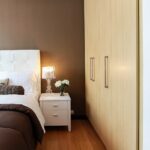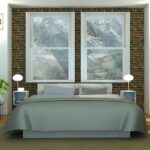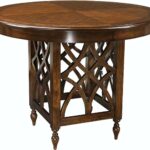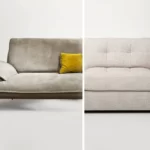Setting up a new TV is exciting, and installing a TV with a theater-style perspective is the best way to watch your favorite shows and movies, relax and unwind. But once you take it apart, you have to figure out where to put it. If you mount your TV too high or too low, you won’t get the best picture quality. Watching your TV at an incorrect height can negatively impact your viewing experience, causing neck and eye strain, so choosing the right height to mount your TV is important. But before you choose a comfortable viewing spot and install a flat-screen TV, there are several factors to consider.
Table of Contents
How High Should You Hang a TV?
Before deciding on how high to hang a TV, it’s important to take into account the following:
Size of TV
This is self-explanatory and represents the viewing area of the TV.
Knowing the size of your TV will help you determine the installation. Remember, when installing a TV, you don’t judge from the floor to the bottom or top, but from the floor to the center of the TV. Also, keep in mind that your TV size will represent the diagonal viewing area. So you’ll need to use a tape measure to figure out how far from the exact center of the screen.
Eye-to-floor Height and Perspective
Your eye height is calculated, not standing, but sitting where you watch TV.
Measure the distance from the floor to your eyes to find out how high you are sitting. In terms of viewing angles, according to the Society of Motion Picture and Television Engineers, you want your TV to be installed with a viewing angle of no more than 30 degrees. However, most people will be inclined at random 10 to 15 degrees.
Observation Distance
The ideal viewing distance also depends on the size of the TV and is the perfect distance from the screen when you watch it. It is calculated by dividing the TV size by 0.55.
How to Decide on Your TV Mounting Height
Eye-level is the best height to install the TV unless you usually watch it down. Depending on the design and setup of the room, you may need to deal with obstacles.
Mount the TV higher unless the obstruction covers the entire wall. When you don’t have room on the wall because of a full-sized fireplace, find a different spot.
It may be necessary to move the furniture, but it’s worth it when you’re comfortable watching the TV, on the other hand, sometimes placing the TV at a higher height doesn’t really matter.
An example of this is the bar TV, which is usually mounted on the wall as customers rarely stick to the TV, so a high installation won’t cause neck strain.
What Calculations Do I Need for Mounting a TV to a Wall?
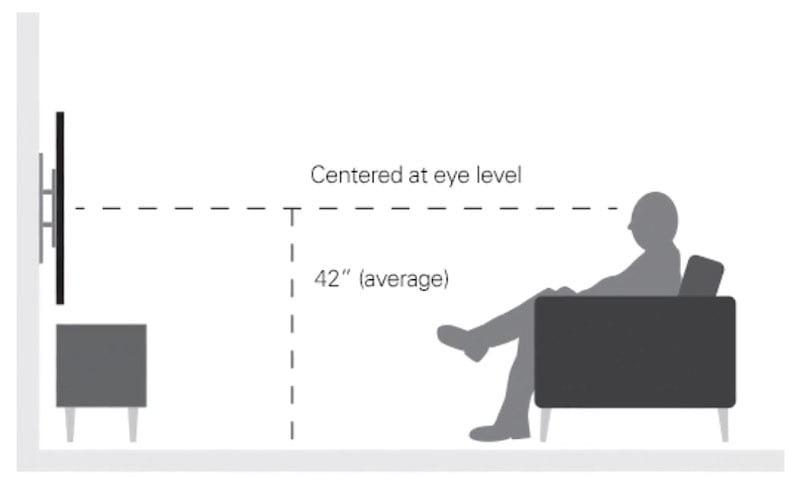
The way to calculate the exact viewing distance and TV mounting height is to take the size and divide it by 0.55. As a quick reference, the optimal viewing distance for a 42-inch TV is 76 inches. For a 55″ guy, you should be 100″ away.
Typically, a 42-inch TV should be mounted about 56 inches off the floor, while a 70-inch TV should be mounted about 67 inches from the center of the screen. But this preference can vary from person to person.
The viewing angle of the TV from the couch or chair is an important factor that determines the hanging height of the TV. In addition to perspective, keep in mind the average eye level with the ground.
Tips for TV Mounting Height
If you want to mount your TV high, or have no other options, a few tools will make the job easier. Dedicated TV mounts secure the TV to the wall.
You can place the TV flat on the wall or tilt it at an angle. Some stands even allow you to raise and lower the screen.
If you must place the TV higher on the wall, here are two wall mounts to watch.
FAQs
How High Should a 32-inch TV Be Mounted?
What Height Should Your TV Be Mounted? Maintaining your TV’s center at eye level while seated is advised by experts. This is normally about 42 inches from the floor to the middle of your TV.
How High Should a 50 Inch TV Be Mounted?
A 50-inch TV should be mounted at what height? A 50 inch TV should be mounted with the top of the TV approximately 67 inches from the floor. To determine how many inches below 67 to install the mount, measure how far down the TV the mount attaches. This mounting height will probably be between 64 and 65 inches off the ground.
How High Should a 55 Inch TV Be Mounted?
How High Should a 55-Inch TV Be Mounted? A 55″ TV should be around 61 inches from the floor to the center of the TV screen.
How High Should a 65 Inch TV Be Mounted?
Your TV’s middle should be at eye level, which is typically 42 inches high, for the best viewing experience. That means a 65-inch TV should typically be mounted about 25 inches from the floor to the bottom of the TV. A TV’s size is determined by measuring it from corner to corner.
How High Should a 75 Inch TV Be Mounted?
Your television must be at eye level, which is typically 42 inches high, in order to provide the best viewing experience. That means a 75-inch TV should typically be mounted about 24 inches from the floor to the bottom of the TV.
TV Height from Floor
Should You Mount Your TV High or Low? Keep your TV’s middle at eye level while seated, according to experts. This is normally about 42 inches from the floor to the middle of your TV.
Conclusion
You can always stand the TV upright with a simple stand, a method that works for anyone who is flat at eye level. In other words, in this case, you don’t have to worry about installing the TV, but unfortunately, most TV users aren’t that lucky because they need to mount the TV on the wall.
Before installing the stand, consider the viewing distance and angle, as you don’t want to have constant neck pain every time you watch TV. A TV stand is a handy device to keep your TV at a high height.
Most tilt and swivel so you can see the screen from almost any vantage point. If you must mount the TV above eye level, consider a TV mount that drops vertically. You can put it down while you’re using the TV and bring it back when you’re done.


